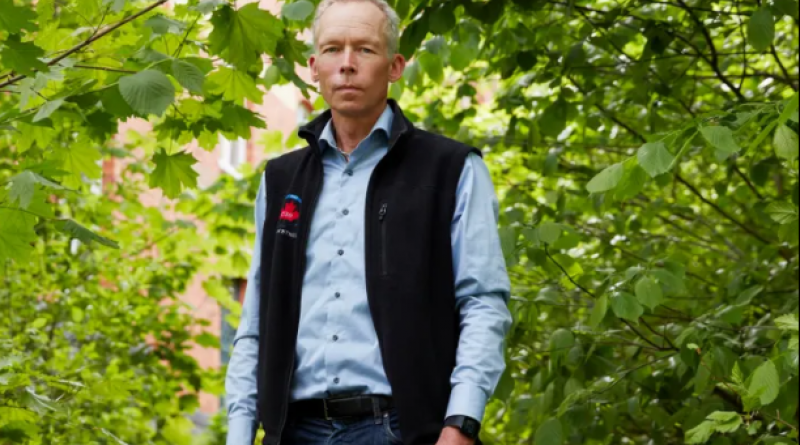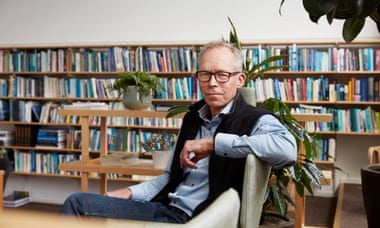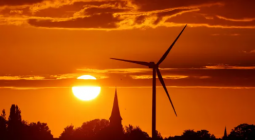Johan Rockström: ‘We need bankers as well as activists… we have 10 years to cut emissions by half’

The eminent Earth scientist argues that we cannot just wait for the world order to change when it comes to tackling the climate crisis – we all have a duty to act now
Johan Rockström is one of the world’s most influential Earth scientists. As director of the Potsdam Institute for Climate Impact Research, he advises governments, corporations and activists, including his Swedish compatriot, Greta Thunberg, about the latest research on the climate and biodiversity and argues for better science communication. Last year, he co-edited Standing Up for a Sustainable World, a book that brought together essays from climatologists, economists, environmental defenders, financiers and school strike activists. In recent months, he has teamed up with David Attenborough to create a new Netflix series, Breaking Boundaries: The Science of Our Planet, participated in President Joe Biden’s climate summit and co-organised a declaration by more than 100 Nobel laureates.
The Nobel prize summit in April declared a planetary emergency. Why now? Scientists have known for at least three decades that human activity is destabilising the climate and accelerating the collapse of ecosystems.
This statement, signed by 126 Nobel laureates, is a world record. Never before have we seen such a global uprising of Nobel prize winners. They issued an emergency call from science to humanity, calling for reason, truth and humanism in the transformation towards an equitable and prosperous future in a safe operating space.
An emergency is calculated by risk divided by time. Risk is probability multiplied by impact. Scientifically, we now have a very unfortunate set of data in front of us. We know that the likely impact on humans of climate disruption, mass extinction and air pollution is very, very high indeed. The probability is also uncomfortably high. This adds up to a very high risk. Now divide that by time. We have unequivocal evidence that we have entered a decisive decade. If we have any chance to prevent the loss of more than a million species, we must halt biodiversity loss now, not in 20 or 30 years. If we want to have any chance of keeping global warming to 1.5C, we need to cut emissions by half over the next nine years. That is what the Nobel laureates and other scientists are speaking out about. This isn’t just a matter of raising the volume on the same old data - it is a new juncture. We are running out of time.
In 2018, you co-authored the Hothouse Earth discussion paper, which warned that our planet could start drifting towards an uninhabitable state if warming exceeds the Paris Agreement target of 2 Celsius.. In the three years since, have you seen any evidence for this?
My hypothesis still stands, though we have since seen new research that both strengthens and eases concerns. On the negative side, we have passed three important tipping points: Arctic summer ice, tropical coral reef systems and parts of the west Antarctic have, as far as the latest science shows, reached the point of no return.
We are also seeing more evidence of a weakening of the Atlantic meridional overturning circulation (AMOC) an effect of ice melt from Greenland and the Arctic that reduces the salinity and temperature gradient between warmer salty water flowing north from the equator and colder less salty water in the north atlantic, which in turn slows ocean and atmospheric currents, with impacts on regional climate systems such as the Amazon monsoon. Slower flow of warm waters from south to north, can also explain why the southern ocean is warming so fast, which in turn has led to accelerated melting of the west Antarctic ice sheets. These cascades are a core feature of a potential drift to a hothouse Earth.
We will see further support for our hypothesis in the forthcoming IPCC 6 (Intergovernmental Panel on Climate Change) assessment, which for the first time will show a change in the climate sensitivity range (the amount of warming projected by computer models if humanity doubles the amount of carbon dioxide in the atmosphere). In the five previous assessments, the IPCC estimated this range would be between 1.5C and 4.5C. In the sixth assessment that will be compacted. The higher point of 4.5C will remain, while the lower point will climb to 2.3C. This means we no longer have a range that goes from a manageable 1.5C to disastrous over 4C. Now the range is from very dangerous (above 2C, which can lead to a hothouse Earth) to catastrophic (over 4C). If we continue as we are, we are very unlikely to remain under 2C in 30 or 40 years.
The third piece of negative new research comes from the new climate model at the Potsdam Institute, which is the first to reproduce the temperature and ice on Earth over the past 3m years. Remarkably, this study shows that during this period, the world has not once passed 2C of warming – the hothouse Earth threshold that we postulated. It was not because of a gentle sun that the Earth remained in that temperature corridor, it was because of regulating feedbacks in the Earth system, such as ocean carbon uptake, terrestrial sinks, the albedo effect of the icecaps, and so on. We want this new model to examine whether 2C of human-forced warming will push the Earth into a runaway hothouse state or whether it can land back into an equilibrium state similar to that of the Holocene period.
How about evidence to the contrary? Are there studies that suggest we can avoid a hothouse state?
On the more positive side, the biggest unknown is how the oceans will behave. What we see in several of the model inter-comparisons coordinated by the World Climate Research programme is that if we completely halt all greenhouse gas emissions, then the ocean will mop up the damage done to the climate system. That is under the assumption that ocean currents continue operating as now and that there are no further nasty surprises. It would come with very negative secondary effects: long-term ocean acidification, damage to marine life and perturbations of the heat conveyor belt in the ocean. Despite that, overall, I must admit I find it reassuring that the ocean might be able to continue buffering and ultimately clean up. But we urgently need more research on whether or not our planet can keep up its resilience and dampen warming or start self-amplifying warming.
The second positive is that there is evidence that it is never worth giving up. Regardless of whether we can phase out fossil fuels fast enough to stay within a 1.5C increase, there is a benefit to doing everything we can. Even after a period of overshoot, of challenging decades of air pollutants and climate extremes, if we can completely phase out greenhouse emissions and go to zero carbon in an absolute sense, then we still have a chance to return within a Holocene-like state.
You have argued for a new approach in science communication to convey more urgency and agency. In Standing Up for a Sustainable World, you urge a more positive message of prosperity and fairness that can attract an otherwise indifferent majority. How can this be achieved?
After 50 years of trying to communicate risks, there is a rapidly rising recognition among environmental and Earth system scientists that we need to back off from an approach of just raising awareness and encouraging a willingness to pay. Indirectly, this creates a trade-off. People feel they have to choose between immediate wealth and protecting the planet. That is an obsolete and incorrect way of communicating. The indifferent majority will only come with us if the sustainable route is not just more attractive but easier. The moment we succeed is when people are sustainable without knowing it; they simply choose the right tomatoes because they taste better and they are cheaper.
The counterargument is that more strident activism and a wider sense of alarm are getting the scientific message out more effectively than science has managed by itself. Talk of prosperity and equality is nice, but isn’t this more effective when reinforced by a fear of the likely consequences if we don’t change? Isn’t it necessary to see the abyss in order to step back so that fear is not paralysing but motivating?
Yes, I’m on your side here. We have a responsibility to communicate the danger, the fear. As scientists, we have long tended to play down the risks. We confused society with sophisticated terms about uncertainty ranges and probability levels. Fridays for Future activists make the threat much clearer.
All the cards need to be put on the table. The patient is sick and we must do a transparent diagnosis. We are clearly close to the point that can lead to disaster. A science based fear element is justified and important.
Activism is a necessary force for change, but it can be counterproductive if the indifferent majority thinks everything to do with the environment is about barricades, breaking down the world order and an alternative lifestyle – that doesn’t attract the mainstream. We need all forces. Tree-huggers and frontier activists are very important but they can’t tip this whole thing over by themselves. We also need the bankers and executives. Why? Because we have only 10 years to cut emissions by half. We cannot change the economic model in 10 years. We can’t forbid everyone to do things in 10 years. We can’t re-educate whole populations in that time. We have to be very tactical.
What is the role of the media and celebrities? David Attenborough is the narrator of your new Netflix series, which explores our understanding of the Earth’s life support system. Compared with a few years ago, he has taken a more strident activist-journalist stance over the planetary crisis. How important is this?
David Attenborough is a prime example of what we need to see more widely in society. We need to see people in all walks of life, particularly those who are widely respected such as sports stars and musicians, to come out and say enough is enough. Attenborough has been the most important voice for nature in the world for two generations. Over the past five years, he has moved very drastically from love for nature to the need for planetary stability. This journey has taken him to a much stronger engagement with climate. He is an authoritative and trustworthy source for so many indifferent people. That really helps him get the message across. When he came to the World Economic Forum in Davos for the first time a few years ago, he basically owned the place. His arrival on stage was the moment that made everyone willing to step onboard. It was remarkable.
He also adds an extraordinary capacity to communicate and superb visualisation skills. It is a magic combination. Attenborough’s last film, A Life on Our Planet, was the best nature documentary ever produced. We explore the science behind it in our new documentary, Breaking Boundaries. It is a very sustainable follow-up because Netflix and Silverback Films allowed us to use the footage that wasn’t included in the original series so we didn’t need to do any new nature shoots.
Greta Thunberg is another key ally in this heightened communication effort. How close are you to her and how important is she – and other youth activists – as an interface between science and the public?
What Greta has been able to do, along with the whole youth climate movement, including Adélaïde Charlier in Belgium Luisa Neubauer in Germany and Xiye Bastidea in Mexico – is to compel decision-makers around the world really listen to science.
In 2018, when Fridays for Future held its first international demonstration in Berlin, I invited Greta to come to the Potsdam Institute to meet our scientists and have a closed-door seminar on the latest climate research. She immediately said yes and I sent an electric car to pick up her and Luisa. Since then, many in the scientific community are informally offering our knowledge to Fridays for Future. They are hungry to learn.
I am in relatively frequent contact with Greta. I spoke to her this month. She had a session with the Swedish prime minister about a European green deal follow-up and wanted assessments. These are clever young people. Our exchanges are very informal. I do them because I think they are so fantastic and that they can make a real difference.
We in the science community have a responsibility to communicate science. We need to be very active in the science-policy interface, the science-business interface and the science-society interface. Now is the time for science to step up. We should see the youth movement as fantastic proof of the transformation we are seeing right in front of our eyes right now. We scientists should surf along, not behind the backs of youth, but holding hands with them.
This informal coalition of science, youth and celebrity seems to be making a difference, at least in terms of public opinion. The leading US climatologist Michael Mann recently told me the prospects for change are better now than at any time he can remember. Do you share that sentiment?
I can’t say this is the most optimistic I have been, but this is certainly a moment. It is like a ketchup bottle. You try and try to get something out and then suddenly a lot splurges out – 2021 is the year when lots come out.
The biggest positive development right now is that the three biggest economies in the world – the US, China and the EU are aligning behind the scenes. The US and EU are committed to net zero emissions in 2050, and China by 2060, which is a bit too late but a start. This is due to Biden coming in. It will have a spill-over effect on the global economy. The three biggest economies are saying: “We are now at the beginning of the end of the fossil fuel era. We are going to cut emissions by half in a decade and reach net zero.”

There was another unexpected blob of ketchup with the launch of a net zero banking alliance during Biden’s climate summit. It has taken a very long time to mobilise financial institutions behind a net zero pathway. Now we quite abruptly got it. This is important. They are the tap in the whole global economy. If you can get private banks, central banks and financial institutions on side, you can cut the flow of fossil fuel investment very fast.
I am also encouraged by the race to decarbonise in the global car industry, which is nothing less than remarkable. Here in Germany, I sit on the sustainability advisory boards both for Daimler lorries and Mercedes-Benz cars. A few years ago, a chief executive would never participate in such meetings now he is here frequently because the key discussion in the company is how to accelerate to net zero. That is what we are seeing across industry. Agriculture is lagging behind, but the debate there is becoming more mature. I am not as optimistic as Mann, but we have shifted the narrative and it is much more aligned with what is needed, namely, that the sustainability across different industries, now is understood as the path to profits and business survival.
Finally, what makes a person like me most enthusiastic is that we are finally understanding that landing the Paris agreement is not just about eradicating fossil fuels, but about remaining within planetary boundaries. We need to keep carbon sinks in nature intact. We need to take care of the nitrogen, water and phosphorus cycles. Cop26 in Glasgow should be the first major climate conference where the climate agenda and the nature agenda come together. Let’s see if that succeeds but many forces are trying to push it to that point.
That said, we are still on the wrong path. Bolsonaro is still cutting down the Amazon and we are still losing carbon sinks. This is quite a nervous moment. We have all those positives but we are still on a negative trend line. Which way will the world tip? But I agree with Mann insofar as we are at a point where the solutions are no longer seen as utopian fantasies but as scalable, replicable and achievable in one generation.
Can we trust net zero targets? They can serve as an excuse for inaction, as my colleague Damian Carrington and others have pointed out.
If we could get rid of the “net” in net zero, I’d be the first to throw it away. There are huge risks of misuse. The only reason why I, the IPCC and most other scientists accept net is there is no choice. There is no plausible chance of an absolute zero landing by 2050. There will be a residual of at least 5 gigatonnes of CO2 equivalent a year by 2050, due to methane fluxes, difficult-to-debate sectors, slow transitions in many developing countries and invested assets that cannot be completely stranded. So we need net. The question is how to deal with it. Rule one is that we must follow the carbon law, which means no compromises on cutting emissions of black carbon from fossil fuels by half every decade. That is the pace and that is non-negotiable. Everything under that curve should be offset with investments in nature-based solutions or different forms of offsetting. I argue we should aim for carbon neutrality today, not 2050. Many companies do this, by the way. Walmart tries to do that now.
What is disturbing is when a company such as Shell puts out a scenario that it says is compatible with 1.5C and will reach net zero a few years after 2050. At first sight, Shell’s “Sky” scenario looks good, but scratch the surface and you see it is a seductive but completely incorrect analysis. It plans a very slow phase out of emissions, considerable overshoot and then a landing at zero emissions by 2070. It pushes this forward to 2058 by planting trees. That is an example of kicking the can down the road. This is not allowed. We have a responsibility to call out those who use “net” or “magic bullet” technological fixes such as carbon capture and storage and geoengineering to push emission reductions into the future. This has plagued discussion for too long. There has to be more independent and institutionalised ways of scrutinising this and holding commitments to account. We can’t allow nationally determined contributions at Cop26 to permit delayed phase outs with this net trick to slow emission reductions paths.
But it is wrong to say nothing has changed. We scientists have been talking about 2050 for so long and the target year is actually approaching. And we are now pushing very hard for strong 2030 goals, which is just nine years away. We can still win.
*Jonathan Watts is the Guardian’s global environment editor and an unpaid contributor to the book that Rockström co-edited Standing Up for a Sustainable World.
29 May 2021
The Guardian




